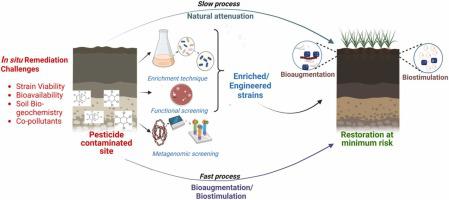Journal of Hazardous Materials ( IF 12.2 ) Pub Date : 2022-09-05 , DOI: 10.1016/j.jhazmat.2022.129906 Priyanka Bokade 1 , Vivek Kumar Gaur 2 , Varsha Tripathi 3 , Shishir Bobate 1 , Natesan Manickam 3 , Abhay Bajaj 1

|
几十年来,农药污染场地的开垦一直是一个具有挑战性的途径。由于农业需求不断增加,合成农药的使用无法控制,现已对土壤、水和相关生态系统产生不利影响,对人类健康造成不利影响。尤其是农业土壤和农药生产场所,由于直接接触,是污染最严重的场所之一。在土壤复垦的各种策略中,生态友好型微生物生物修复面临着大规模现场应用的固有挑战,因为微生物与污染土壤的相互作用在气候条件下变化很大。有条不紊地,从功能或基因组筛选、富集分离开始;功能通路映射,生产张力活性代谢物以提高生物利用度和生物可及性,采用基因工程策略对现有分解代谢基因进行修饰以增强降解活性;每一步降解研究都有挑战和前景,可以解决这些挑战和前景,以便成功应用。本综述批判性地研究了解决恢复和回收农药污染场地的可行性以及生态毒理学风险评估的系统性挑战。总体而言,它强调了对现有流程进行微调并采用跨学科方法使微生物辅助生物修复成为农药污染场地开垦的首选方法的必要性。采用基因工程策略对现有分解代谢基因进行修饰,以增强降解活性;每一步降解研究都有挑战和前景,可以解决这些挑战和前景,以便成功应用。本综述批判性地研究了解决恢复和回收农药污染场地的可行性以及生态毒理学风险评估的系统性挑战。总体而言,它强调了对现有流程进行微调并采用跨学科方法使微生物辅助生物修复成为农药污染场地开垦的首选方法的必要性。采用基因工程策略对现有分解代谢基因进行修饰,以增强降解活性;每一步降解研究都有挑战和前景,可以解决这些挑战和前景,以便成功应用。本综述批判性地研究了解决恢复和回收农药污染场地的可行性以及生态毒理学风险评估的系统性挑战。总体而言,它强调了对现有流程进行微调并采用跨学科方法使微生物辅助生物修复成为农药污染场地开垦的首选方法的必要性。本综述批判性地研究了解决恢复和回收农药污染场地的可行性以及生态毒理学风险评估的系统性挑战。总体而言,它强调了对现有流程进行微调并采用跨学科方法使微生物辅助生物修复成为农药污染场地开垦的首选方法的必要性。本综述批判性地研究了解决恢复和回收农药污染场地的可行性以及生态毒理学风险评估的系统性挑战。总体而言,它强调了对现有流程进行微调并采用跨学科方法使微生物辅助生物修复成为农药污染场地开垦的首选方法的必要性。

"点击查看英文标题和摘要"





















































 京公网安备 11010802027423号
京公网安备 11010802027423号